Worksheet Review of Atoms Molecules Ions and Isotopes
The Chemical Foundation of Life
5 Atoms, Isotopes, Ions, and Molecules: The Building Blocks
Learning Objectives
Past the end of this department, you will be able to do the following:
- Define affair and elements
- Describe the interrelationship between protons, neutrons, and electrons
- Compare the means in which electrons tin can be donated or shared between atoms
- Explain the ways in which naturally occurring elements combine to create molecules, cells, tissues, organ systems, and organisms
At its nearly fundamental level, life is made up of matter. Matter is any substance that occupies infinite and has mass. Elements are unique forms of matter with specific chemic and physical properties that cannot intermission down into smaller substances by ordinary chemical reactions. In that location are 118 elements, but only 98 occur naturally. The remaining elements are unstable and require scientists to synthesize them in laboratories.
Each element is designated by its chemical symbol, which is a single capital alphabetic character or, when the get-go letter is already "taken" by another element, a combination of two messages. Some elements follow the English term for the element, such as C for carbon and Ca for calcium. Other elements' chemical symbols derive from their Latin names. For example, the symbol for sodium is Na, referring to natrium, the Latin give-and-take for sodium.
The four elements mutual to all living organisms are oxygen (O), carbon (C), hydrogen (H), and nitrogen (N). In the nonliving world, elements are plant in different proportions, and some elements mutual to living organisms are relatively rare on the world as a whole, equally (Effigy) shows. For example, the atmosphere is rich in nitrogen and oxygen but contains piffling carbon and hydrogen, while the earth's crust, although information technology contains oxygen and a small amount of hydrogen, has little nitrogen and carbon. In spite of their differences in affluence, all elements and the chemical reactions between them obey the aforementioned chemic and physical laws regardless of whether they are a part of the living or nonliving world.
| Approximate Percentage of Elements in Living Organisms (Humans) Compared to the Nonliving World | |||
|---|---|---|---|
| Element | Life (Humans) | Temper | Earth's Crust |
| Oxygen (O) | 65% | 21% | 46% |
| Carbon (C) | 18% | trace | trace |
| Hydrogen (H) | ten% | trace | 0.1% |
| Nitrogen (N) | 3% | 78% | trace |
The Structure of the Atom
To understand how elements come together, nosotros must first hash out the element'south smallest component or building block, the atom. An cantlet is the smallest unit of matter that retains all of the element's chemic properties. For example, ane gold atom has all of the properties of gold in that it is a solid metal at room temperature. A gold money is simply a very large number of gilded atoms molded into the shape of a money and contains pocket-size amounts of other elements known as impurities. Nosotros cannot suspension down gold atoms into annihilation smaller while still retaining the properties of gold.
An atom is composed of two regions: the nucleus, which is in the atom's center and contains protons and neutrons. The atom's outermost region holds its electrons in orbit around the nucleus, as (Effigy) illustrates. Atoms contain protons, electrons, and neutrons, amidst other subatomic particles. The only exception is hydrogen (H), which is made of one proton and i electron with no neutrons.
Elements, such as helium, depicted here, are made up of atoms. Atoms are fabricated up of protons and neutrons located within the nucleus, with electrons in orbitals surrounding the nucleus.
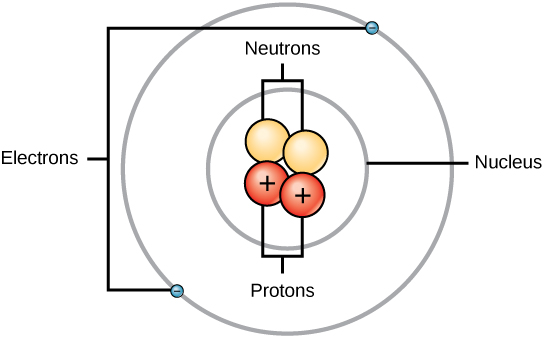
Protons and neutrons have approximately the same mass, about i.67 × 10-24 grams. Scientists arbitrarily define this corporeality of mass equally ane atomic mass unit (amu) or ane Dalton, as (Figure) shows. Although similar in mass, protons and neutrons differ in their electrical charge. A proton is positively charged; whereas, a neutron is uncharged. Therefore, the number of neutrons in an atom contributes significantly to its mass, but non to its accuse. Electrons are much smaller in mass than protons, weighing just 9.11 × ten-28 grams, or about i/1800 of an atomic mass unit. Hence, they do not contribute much to an element's overall atomic mass. Therefore, when considering diminutive mass, information technology is customary to ignore the mass of any electrons and calculate the atom's mass based on the number of protons and neutrons alone. Although not significant contributors to mass, electrons practise contribute greatly to the atom'due south charge, equally each electron has a negative charge equal to the proton's positive accuse. In uncharged, neutral atoms, the number of electrons orbiting the nucleus is equal to the number of protons inside the nucleus. In these atoms, the positive and negative charges abolish each other out, leading to an atom with no net charge.
Accounting for the sizes of protons, neutrons, and electrons, most of the atom's volume—greater than 99 percentage—is empty space. With all this empty space, one might ask why so-called solid objects do not but pass through ane some other. The reason they do not is that the electrons that surround all atoms are negatively charged and negative charges repel each other.
| Protons, Neutrons, and Electrons | |||
|---|---|---|---|
| Charge | Mass (amu) | Location | |
| Proton | +one | 1 | nucleus |
| Neutron | 0 | 1 | nucleus |
| Electron | –1 | 0 | orbitals |
Atomic Number and Mass
Atoms of each element contain a characteristic number of protons and electrons. The number of protons determines an chemical element'due south atomic number, which scientists use to distinguish one element from some other. The number of neutrons is variable, resulting in isotopes, which are different forms of the same atom that vary but in the number of neutrons they possess. Together, the number of protons and neutrons determine an element'due south mass number, as (Figure) illustrates. Note that we disregard the small contribution of mass from electrons in calculating the mass number. We tin use this approximation of mass to hands summate how many neutrons an chemical element has by simply subtracting the number of protons from the mass number. Since an element's isotopes will have slightly different mass numbers, scientists too determine the atomic mass, which is the calculated mean of the mass number for its naturally occurring isotopes. Often, the resulting number contains a fraction. For case, the atomic mass of chlorine (Cl) is 35.45 considering chlorine is equanimous of several isotopes, some (the majority) with atomic mass 35 (17 protons and xviii neutrons) and some with diminutive mass 37 (17 protons and 20 neutrons).
Visual Connection
Carbon has an atomic number of 6, and two stable isotopes with mass numbers of twelve and 13, respectively. Its relative atomic mass is 12.011
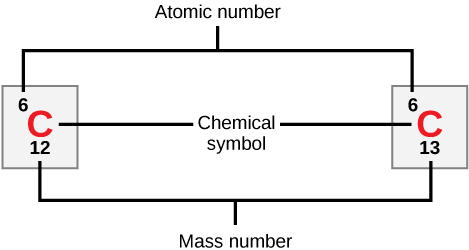
How many neutrons practice carbon-12 and carbon-13 have, respectively?
<!–<para> Carbon-12 has six neutrons. Carbon-13 has seven neutrons.–>
Isotopes
Isotopes are different forms of an chemical element that have the same number of protons merely a different number of neutrons. Some elements—such equally carbon, potassium, and uranium—have naturally occurring isotopes. Carbon-12 contains half-dozen protons, six neutrons, and six electrons; therefore, it has a mass number of 12 (six protons and half-dozen neutrons). Carbon-fourteen contains 6 protons, eight neutrons, and six electrons; its atomic mass is 14 (six protons and eight neutrons). These ii alternate forms of carbon are isotopes. Some isotopes may emit neutrons, protons, and electrons, and attain a more than stable atomic configuration (lower level of potential energy); these are radioactive isotopes, or radioisotopes. Radioactivity (carbon-14 decaying to eventually get nitrogen-fourteen) describes the free energy loss that occurs when an unstable atom's nucleus releases radiation.
Development Connection
Carbon Dating
Carbon is normally present in the atmosphere in the form of gaseous compounds similar carbon dioxide and methane. Carbon-14 (fourteenC) is a naturally occurring radioisotope that is created in the atmosphere from atmospheric 14N (nitrogen) past the addition of a neutron and the loss of a proton because of catholic rays. This is a continuous process, and so more than 14C is always existence created. Every bit a living organism incorporates 14C initially as carbon dioxide fixed in the procedure of photosynthesis, the relative amount of fourteenC in its body is equal to the concentration of fourteenC in the atmosphere. When an organism dies, it is no longer ingesting 14C, and then the ratio between fourteenC and 12C volition pass up as 14C decays gradually to 14Northward by a procedure chosen beta disuse—electrons or positrons emission. This decay emits energy in a slow process.
Subsequently approximately 5,730 years, half of the starting concentration of 14C will catechumen back to 14North. We call the time information technology takes for half of the original concentration of an isotope to disuse back to its more stable course its half-life. Considering the half-life of 14C is long, scientists utilise it to date formerly living objects such every bit erstwhile basic or wood. Comparing the ratio of the 14C concentration in an object to the amount of 14C in the atmosphere, scientists tin determine the amount of the isotope that has not still decayed. On the ground of this amount, (Effigy) shows that we can summate the historic period of the cloth, such as the pygmy mammoth, with accuracy if it is not much older than nigh 50,000 years. Other elements have isotopes with different half lives. For example, 40Grand (potassium-40) has a half-life of 1.25 billion years, and 235U (Uranium 235) has a one-half-life of about 700 meg years. Through the use of radiometric dating, scientists can written report the age of fossils or other remains of extinct organisms to understand how organisms take evolved from earlier species.
Scientists can make up one's mind the age of carbon-containing remains less than about fifty,000 years old, such equally this pygmy mammoth, using carbon dating. (credit: Bill Faulkner, NPS)
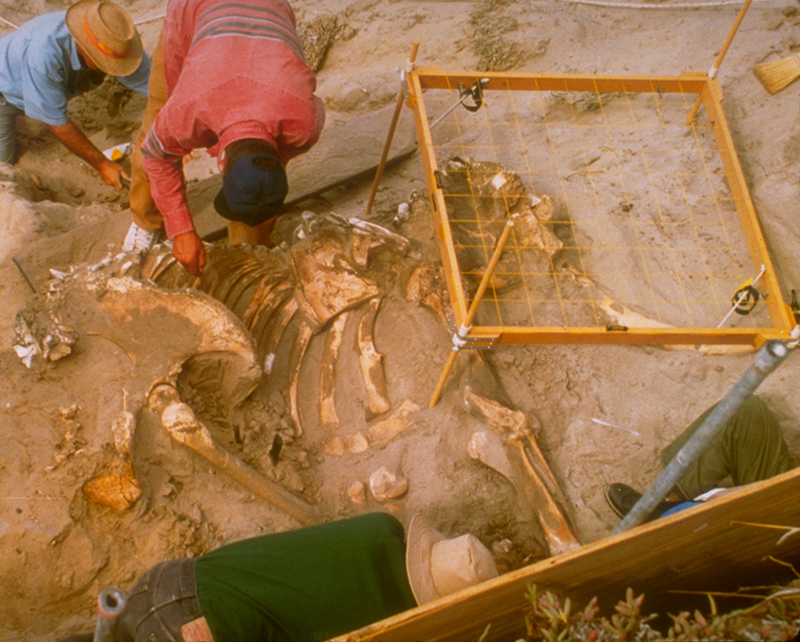
Link to Learning
To learn more nearly atoms, isotopes, and how to tell one isotope from another, run the simulation.
The Periodic Table
The periodic table organizes and displays different elements. Devised past Russian pharmacist Dmitri Mendeleev (1834–1907) in 1869, the table groups elements that, although unique, share certain chemical properties with other elements. The properties of elements are responsible for their physical state at room temperature: they may be gases, solids, or liquids. Elements also take specific chemical reactivity, the ability to combine and to chemically bond with each other.
In the periodic table in (Figure), the elements are organized and displayed co-ordinate to their atomic number and are arranged in a series of rows and columns based on shared chemical and physical properties. In add-on to providing the atomic number for each element, the periodic tabular array also displays the element'due south atomic mass. Looking at carbon, for example, its symbol (C) and name appear, also as its atomic number of six (in the upper left-mitt corner) and its atomic mass of 12.xi.
The periodic table shows each element's atomic mass and atomic number. The diminutive number appears to a higher place the symbol for the chemical element and the approximate diminutive mass appears below it.
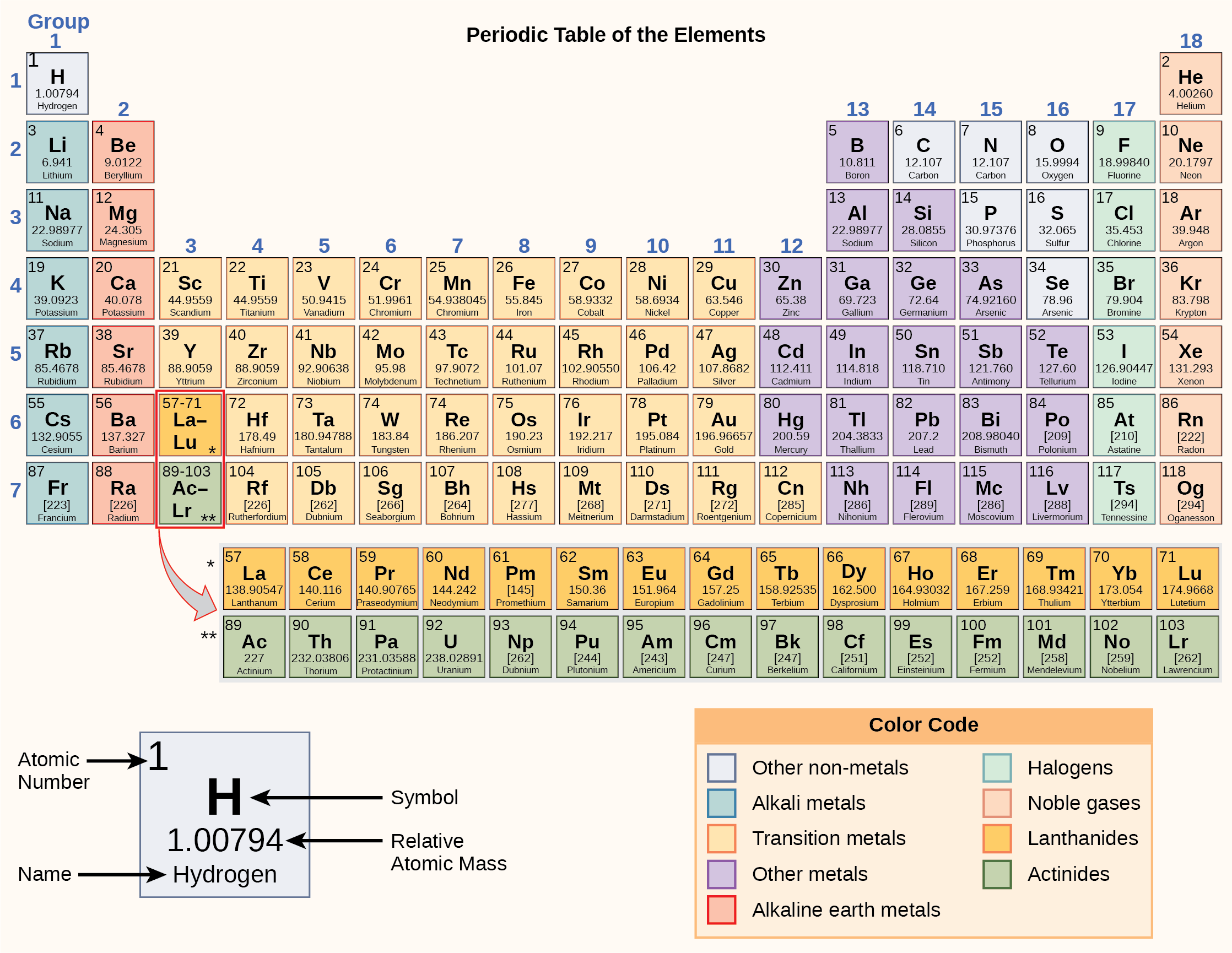
The periodic table groups elements co-ordinate to chemical properties. Scientists base the differences in chemical reactivity betwixt the elements on the number and spatial distribution of an atom's electrons. Atoms that chemically react and bail to each other form molecules. Molecules are simply two or more atoms chemically bonded together. Logically, when two atoms chemically bond to form a molecule, their electrons, which form the outermost region of each atom, come together first as the atoms course a chemical bond.
Electron Shells and the Bohr Model
Note that at that place is a connection between the number of protons in an element, the atomic number that distinguishes 1 element from another, and the number of electrons information technology has. In all electrically neutral atoms, the number of electrons is the same equally the number of protons. Thus, each element, at least when electrically neutral, has a characteristic number of electrons equal to its atomic number.
In 1913, Danish scientist Niels Bohr (1885–1962) developed an early model of the atom. The Bohr model shows the atom as a central nucleus containing protons and neutrons, with the electrons in circular orbitals at specific distances from the nucleus, as (Figure) illustrates. These orbits form electron shells or energy levels, which are a way of visualizing the number of electrons in the outermost shells. These energy levels are designated by a number and the symbol "n." For instance, 1n represents the first energy level located closest to the nucleus.
In 1913, Niels Bohrs developed the Bohr model in which electrons exist within master shells. An electron normally exists in the everyman energy beat bachelor, which is the 1 closest to the nucleus. Energy from a photon of light can bump it up to a college free energy shell, but this situation is unstable, and the electron rapidly decays back to the footing state. In the procedure, it releases a photon of lite.
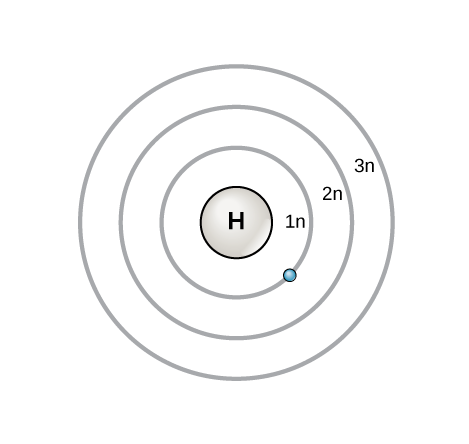
Electrons fill orbitals in a consistent lodge: they first fill the orbitals closest to the nucleus, then they keep to fill orbitals of increasing free energy further from the nucleus. If at that place are multiple orbitals of equal energy, they fill up with 1 electron in each free energy level before calculation a second electron. The electrons of the outermost energy level decide the atom's energetic stability and its trend to form chemic bonds with other atoms to course molecules.
Under standard weather condition, atoms fill up the inner shells first, often resulting in a variable number of electrons in the outermost crush. The innermost trounce has a maximum of two electrons but the next two electron shells can each have a maximum of viii electrons. This is known as the octet rule, which states, with the exception of the innermost shell, that atoms are more stable energetically when they have viii electrons in their valence vanquish, the outermost electron trounce. (Effigy) shows examples of some neutral atoms and their electron configurations. Find that in (Figure), helium has a consummate outer electron beat out, with two electrons filling its starting time and only shell. Similarly, neon has a complete outer 2n crush containing viii electrons. In dissimilarity, chlorine and sodium have vii and ane in their outer shells, respectively, but theoretically they would be more energetically stable if they followed the octet rule and had viii.
Visual Connection
Bohr diagrams indicate how many electrons fill each chief vanquish. Grouping xviii elements (helium, neon, and argon) have a total outer, or valence, beat out. A full valence shell is the most stable electron configuration. Elements in other groups have partially filled valence shells and gain or lose electrons to accomplish a stable electron configuration.
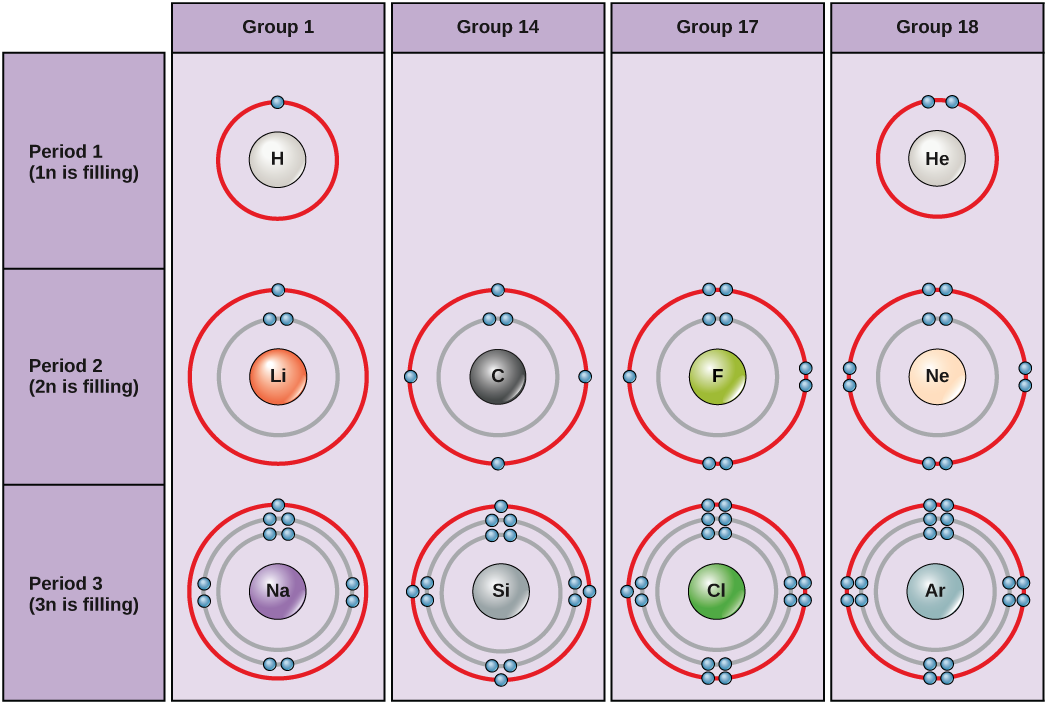
An atom may give, take, or share electrons with another atom to achieve a full valence shell, the most stable electron configuration. Looking at this figure, how many electrons do elements in group 1 need to lose in order to achieve a stable electron configuration? How many electrons do elements in groups xiv and 17 demand to gain to attain a stable configuration?
<!–<para>Elements in group 1 demand to lose one electron to achieve a stable electron configuration. Elements in groups fourteen and 17 demand to gain iv and one electrons, respectively, to achieve a stable configuration.–>
Understanding that the periodic table's organisation is based on the total number of protons (and electrons) helps us know how electrons distribute themselves among the shells. The periodic tabular array is arranged in columns and rows based on the number of electrons and their location. Examine more closely some of the elements in the table's far correct cavalcade in (Effigy). The group 18 atoms helium (He), neon (Ne), and argon (Ar) all have filled outer electron shells, making it unnecessary for them to share electrons with other atoms to attain stability. They are highly stable every bit single atoms. Because they are not reactive, scientists coin them inert (or noble gases). Compare this to the grouping 1 elements in the left-hand column. These elements, including hydrogen (H), lithium (Li), and sodium (Na), all have one electron in their outermost shells. That means that they tin can reach a stable configuration and a filled outer beat by donating or sharing i electron with another atom or a molecule such every bit h2o. Hydrogen will donate or share its electron to achieve this configuration, while lithium and sodium will donate their electron to become stable. As a event of losing a negatively charged electron, they become positively charged ions. Group 17 elements, including fluorine and chlorine, have seven electrons in their outmost shells, so they tend to fill this shell with an electron from other atoms or molecules, making them negatively charged ions. Grouping xiv elements, of which carbon is the most important to living systems, have four electrons in their outer shell allowing them to make several covalent bonds (discussed beneath) with other atoms. Thus, the periodic table'south columns stand for the potential shared state of these elements' outer electron shells that is responsible for their like chemical characteristics.
Electron Orbitals
Although useful to explain the reactivity and chemical bonding of sure elements, the Bohr model does not accurately reflect how electrons spatially distribute themselves around the nucleus. They do not circle the nucleus similar the world orbits the sun, only we find them in electron orbitals. These relatively circuitous shapes result from the fact that electrons behave not just like particles, just also like waves. Mathematical equations from quantum mechanics, which scientists call wave functions, tin predict inside a certain level of probability where an electron might be at any given time. Scientists phone call the area where an electron is well-nigh likely to be found its orbital.
Recall that the Bohr model depicts an cantlet'southward electron crush configuration. Within each electron shell are subshells, and each subshell has a specified number of orbitals containing electrons. While it is incommunicable to calculate exactly an electron's location, scientists know that information technology is almost probably located within its orbital path. The letter s, p, d, and f designate the subshells. The s subshell is spherical in shape and has one orbital. Principal shell 1n has merely a unmarried s orbital, which can hold two electrons. Principal shell 2n has one s and one p subshell, and tin can concord a total of 8 electrons. The p subshell has three dumbbell-shaped orbitals, equally (Figure) illustrates. Subshells d and f have more complex shapes and contain v and seven orbitals, respectively. Nosotros do not show these in the illustration. Principal shell 3n has due south, p, and d subshells and tin hold 18 electrons. Master shell 4n has due south, p, d and f orbitals and tin hold 32 electrons. Moving away from the nucleus, the number of electrons and orbitals in the energy levels increases. Progressing from one atom to the next in the periodic table, we can determine the electron construction past fitting an extra electron into the next available orbital.
The s subshells are shaped like spheres. Both the 1n and 2n chief shells take an s orbital, but the size of the sphere is larger in the 2n orbital. Each sphere is a single orbital. Three dumbbell-shaped orbitals comprise p subshells. Principal vanquish 2n has a p subshell, but shell 1 does not.
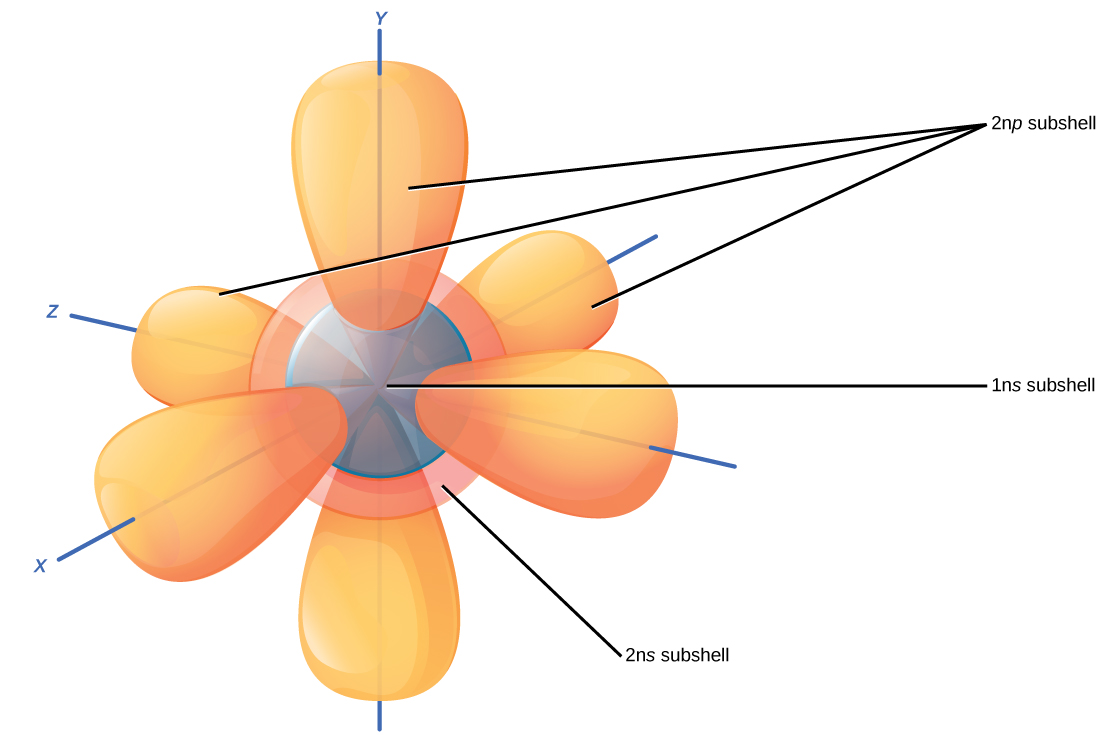
The closest orbital to the nucleus, the 1s orbital, can concur upward to 2 electrons. This orbital is equivalent to the Bohr model'southward innermost electron vanquish. Scientists telephone call it the 1due south orbital because it is spherical effectually the nucleus. The anes orbital is the closest orbital to the nucleus, and it is always filled starting time, before whatever other orbital fills. Hydrogen has i electron; therefore, it occupies simply one spot inside the 1s orbital. We designate this as 1south 1, where the superscripted 1 refers to the one electron inside the 1s orbital. Helium has two electrons; therefore, it tin completely fill the 1south orbital with its two electrons. We designate this every bit is two, referring to the two electrons of helium in the 1s orbital. On the periodic tabular array (Figure), hydrogen and helium are the only two elements in the first row (menstruation). This is because they only take electrons in their first shell, the 1s orbital. Hydrogen and helium are the simply two elements that have the 1s and no other electron orbitals in the electrically neutral state.
The second electron shell may comprise eight electrons. This crush contains another spherical southward orbital and iii "dumbbell" shaped p orbitals, each of which can concur 2 electrons, as (Figure) shows. After the 1due south orbital fills, the second electron shell fills, first filling its iis orbital and and then its three p orbitals. When filling the p orbitals, each takes a single electron. Once each p orbital has an electron, it may add a 2nd. Lithium (Li) contains three electrons that occupy the first and second shells. Two electrons fill up the anesouth orbital, and the 3rd electron and then fills the 2due south orbital. Its electron configuration is 1south two2s one. Neon (Ne), alternatively, has a total of ten electrons: 2 are in its innermost 1due south orbital and 8 make full its second shell (2 each in the 2s and three p orbitals). Thus information technology is an inert gas and energetically stable every bit a single atom that will rarely form a chemical bond with other atoms. Larger elements have boosted orbitals, comprising the third electron shell. While the concepts of electron shells and orbitals are closely related, orbitals provide a more accurate depiction of an atom's electron configuration considering the orbital model specifies the unlike shapes and special orientations of all the places that electrons may occupy.
Link to Learning
Sentry this visual animation to meet the spatial arrangement of the p and s orbitals.
Chemical Reactions and Molecules
All elements are well-nigh stable when their outermost shell is filled with electrons according to the octet rule. This is because it is energetically favorable for atoms to be in that configuration and it makes them stable. Yet, since non all elements have enough electrons to fill their outermost shells, atoms form chemical bonds with other atoms thereby obtaining the electrons they need to attain a stable electron configuration. When ii or more atoms chemically bail with each other, the resultant chemic structure is a molecule. The familiar water molecule, H2O, consists of two hydrogen atoms and i oxygen atom. These bail together to class h2o, every bit (Figure) illustrates. Atoms can form molecules by donating, accepting, or sharing electrons to fill their outer shells.
Two or more atoms may bond with each other to class a molecule. When two hydrogens and an oxygen share electrons via covalent bonds it forms a water molecule.
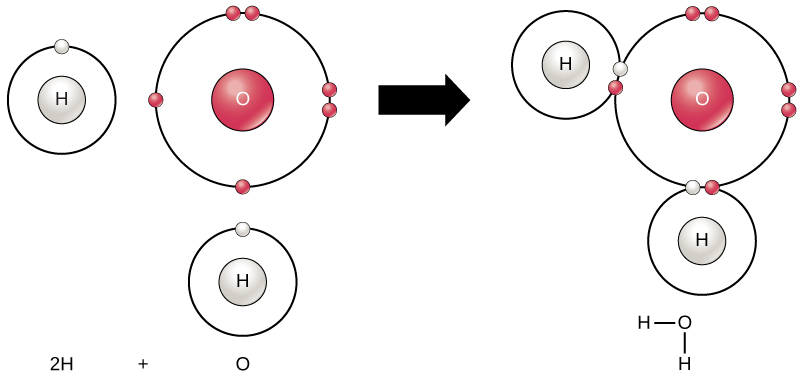
Chemical reactions occur when two or more atoms bond together to form molecules or when bonded atoms break autonomously. Scientists call the substances used in the beginning of a chemical reaction reactants (commonly on the left side of a chemical equation), and we call the substances at the end of the reaction products (usually on the correct side of a chemical equation). We typically describe an pointer between the reactants and products to betoken the chemical reaction's direction. This direction is not always a "one-way street." To create the water molecule to a higher place, the chemical equation would exist:
[latex]two\text{H + O }\to {\text{ H}}_{two}\text{O}[/latex]
An instance of a uncomplicated chemic reaction is breaking down hydrogen peroxide molecules, each of which consists of two hydrogen atoms bonded to ii oxygen atoms (H2O2). The reactant hydrogen peroxide breaks downwardly into water, containing one oxygen atom bound to two hydrogen atoms (H2O), and oxygen, which consists of two bonded oxygen atoms (O2). In the equation beneath, the reaction includes 2 hydrogen peroxide molecules and two water molecules. This is an example of a balanced chemical equation, wherein each element's number of atoms is the same on each side of the equation. According to the police of conservation of matter, the number of atoms before and after a chemical reaction should exist equal, such that no atoms are, nether normal circumstances, created or destroyed.
[latex]{\text{2H}}_{2}{\text{O}}_{two}\text{ (hydrogen peroxide) }\to {\text{ 2H}}_{2}{\text{O (water) + O}}_{2}\text{ (oxygen)}[/latex]
Even though all of the reactants and products of this reaction are molecules (each atom remains bonded to at to the lowest degree one other atom), in this reaction only hydrogen peroxide and water are representatives of compounds: they incorporate atoms of more than one type of chemical element. Molecular oxygen, alternatively, as (Figure) shows, consists of 2 doubly bonded oxygen atoms and is not classified every bit a compound simply equally a hononuclear molecule.
A double bond joins the oxygen atoms in an O2 molecule.

Some chemic reactions, such as the one above, can proceed in one direction until they expend all the reactants. The equations that describe these reactions comprise a unidirectional arrow and are irreversible. Reversible reactions are those that tin can go in either direction. In reversible reactions, reactants turn into products, but when the product'south concentration goes beyond a certain threshold (characteristic of the particular reaction), some of these products convert back into reactants. At this point, product and reactant designations opposite. This back and along continues until a certain relative balance between reactants and products occurs—a state called equilibrium. A chemical equation with a double headed arrow pointing towards both the reactants and products ofttimes denote these reversible reaction situations.
For example, in human being blood, excess hydrogen ions (H+) demark to bicarbonate ions (HCOthree –) forming an equilibrium state with carbonic acid (HiiCOthree). If we added carbonic acid to this system, some of it would convert to bicarbonate and hydrogen ions.
[latex]{{\text{HCO}}_{3}}^{-}{\text{+ H}}^{+}\text{}↔{\text{H}}_{ii}{\text{CO}}_{3}[/latex]
However, biological reactions rarely obtain equilibrium because the concentrations of the reactants or products or both are constantly changing, often with one reaction's product a reactant for some other. To return to the case of backlog hydrogen ions in the blood, forming carbonic acid will be the reaction's major direction. However, the carbonic acid tin also leave the body every bit carbon dioxide gas (via exhalation) instead of converting dorsum to bicarbonate ion, thus driving the reaction to the right past the law of mass action. These reactions are important for maintaining homeostasis in our claret.
[latex]{{\text{HCO}}_{3}}^{-}{\text{ + H}}^{+}\text{ }↔{\text{ H}}_{ii}{\text{CO}}_{iii}\text{ }↔{\text{ CO}}_{2}{\text{ + H}}_{\text{2}}\text{O}[/latex]
Ions and Ionic Bonds
Some atoms are more stable when they gain or lose an electron (or maybe two) and class ions. This fills their outermost electron shell and makes them energetically more stable. Because the number of electrons does not equal the number of protons, each ion has a cyberspace charge. Cations are positive ions that course past losing electrons. Negative ions form by gaining electrons, which we call anions. We designate anions by their elemental name and modify the ending to "-ide", thus the anion of chlorine is chloride, and the anion of sulfur is sulfide.
Scientists refer to this movement of electrons from one element to some other as electron transfer. As (Figure) illustrates, sodium (Na) only has one electron in its outer electron shell. It takes less energy for sodium to donate that i electron than it does to accept 7 more than electrons to fill the outer trounce. If sodium loses an electron, it now has eleven protons, 11 neutrons, and simply 10 electrons, leaving it with an overall accuse of +one. We now refer to it as a sodium ion. Chlorine (Cl) in its lowest energy country (called the basis state) has seven electrons in its outer crush. Once again, it is more free energy-efficient for chlorine to gain one electron than to lose seven. Therefore, it tends to gain an electron to create an ion with 17 protons, 17 neutrons, and 18 electrons, giving it a net negative (–1) charge. We now refer to information technology every bit a chloride ion. In this instance, sodium will donate its one electron to empty its shell, and chlorine volition accept that electron to make full its shell. Both ions now satisfy the octet dominion and have consummate outermost shells. Considering the number of electrons is no longer equal to the number of protons, each is now an ion and has a +ane (sodium cation) or –one (chloride anion) accuse. Notation that these transactions can normally just take place simultaneously: in order for a sodium atom to lose an electron, it must be in the presence of a suitable recipient similar a chlorine cantlet.
In the formation of an ionic compound, metals lose electrons and nonmetals proceeds electrons to attain an octet.

Ionic bonds class between ions with contrary charges. For example, positively charged sodium ions and negatively charged chloride ions bond together to make crystals of sodium chloride, or tabular array salt, creating a crystalline molecule with zero net accuse.
Physiologists refer to certain salts equally electrolytes (including sodium, potassium, and calcium), ions necessary for nerve impulse conduction, musculus contractions, and water balance. Many sports drinks and dietary supplements provide these ions to replace those lost from the torso via sweating during exercise.
Covalent Bonds and Other Bonds and Interactions
Some other way to satisfy the octet rule past sharing electrons betwixt atoms to form covalent bonds. These bonds are stronger and much more mutual than ionic bonds in the molecules of living organisms. We usually discover covalent bonds in carbon-based organic molecules, such as our Deoxyribonucleic acid and proteins. We as well find covalent bonds in inorganic molecules similar HtwoO, CO2, and O2. The bonds may share one, two, or three pairs of electrons, making single, double, and triple bonds, respectively. The more covalent bonds between two atoms, the stronger their connectedness. Thus, triple bonds are the strongest.
The strength of dissimilar levels of covalent bonding is ane of the main reasons living organisms have a hard time in acquiring nitrogen for employ in constructing their molecules, even though molecular nitrogen, N2, is the well-nigh abundant gas in the atmosphere. Molecular nitrogen consists of 2 nitrogen atoms triple bonded to each other and, equally with all molecules, sharing these three pairs of electrons between the 2 nitrogen atoms allows for filling their outer electron shells, making the molecule more stable than the individual nitrogen atoms. This strong triple bond makes information technology hard for living systems to break apart this nitrogen in social club to apply it every bit constituents of proteins and DNA.
Forming water molecules provides an example of covalent bonding. Covalent bonds bind the hydrogen and oxygen atoms that combine to grade water molecules as (Figure) shows. The electron from the hydrogen splits its time between the hydrogen atoms' incomplete outer shell and the oxygen atoms' incomplete outer trounce. To completely make full the oxygen'southward outer vanquish, which has six electrons but which would exist more stable with 8, ii electrons (one from each hydrogen cantlet) are needed: hence, the well-known formula HiiO. The two elements share the electrons to fill up the outer shell of each, making both elements more than stable.
Link to Learning
View this short video to see an animation of ionic and covalent bonding.
Polar Covalent Bonds
In that location are ii types of covalent bonds: polar and nonpolar. In a polar covalent bond, (Figure) shows atoms unequally share the electrons and are attracted more to i nucleus than the other. Because of the unequal electron distribution between the atoms of different elements, a slightly positive (δ+) or slightly negative (δ–) charge develops. This partial accuse is an important property of water and accounts for many of its characteristics.
H2o is a polar molecule, with the hydrogen atoms acquiring a partial positive charge and the oxygen a fractional negative charge. This occurs considering the oxygen atom'southward nucleus is more attractive to the hydrogen atoms' electrons than the hydrogen nucleus is to the oxygen's electrons. Thus, oxygen has a higher electronegativity than hydrogen and the shared electrons spend more than fourth dimension near the oxygen nucleus than the hydrogen atoms' nucleus, giving the oxygen and hydrogen atoms slightly negative and positive charges, respectively. Another way of stating this is that the probability of finding a shared electron about an oxygen nucleus is more than likely than finding it almost a hydrogen nucleus. Either way, the atom's relative electronegativity contributes to developing partial charges whenever ane element is significantly more electronegative than the other, and the charges that these polar bonds generate may then be used to form hydrogen bonds based on the allure of opposite partial charges. (Hydrogen bonds, which nosotros discuss in detail below, are weak bonds between slightly positively charged hydrogen atoms to slightly negatively charged atoms in other molecules.) Since macromolecules often accept atoms inside them that differ in electronegativity, polar bonds are often present in organic molecules.
Nonpolar Covalent Bonds
Nonpolar covalent bonds form between ii atoms of the aforementioned element or between different elements that share electrons every bit. For example, molecular oxygen (Otwo) is nonpolar considering the electrons distribute as between the two oxygen atoms.
(Effigy) also shows another instance of a nonpolar covalent bail—methane (CH4). Carbon has iv electrons in its outermost vanquish and needs four more to fill up it. It obtains these iv from iv hydrogen atoms, each cantlet providing 1, making a stable outer beat out of eight electrons. Carbon and hydrogen do not have the same electronegativity merely are similar; thus, nonpolar bonds form. The hydrogen atoms each demand one electron for their outermost shell, which is filled when it contains two electrons. These elements share the electrons equally among the carbons and the hydrogen atoms, creating a nonpolar covalent molecule.
Whether a molecule is polar or nonpolar depends both on bail blazon and molecular shape. Both h2o and carbon dioxide accept polar covalent bonds, simply carbon dioxide is linear, so the partial charges on the molecule abolish each other out.
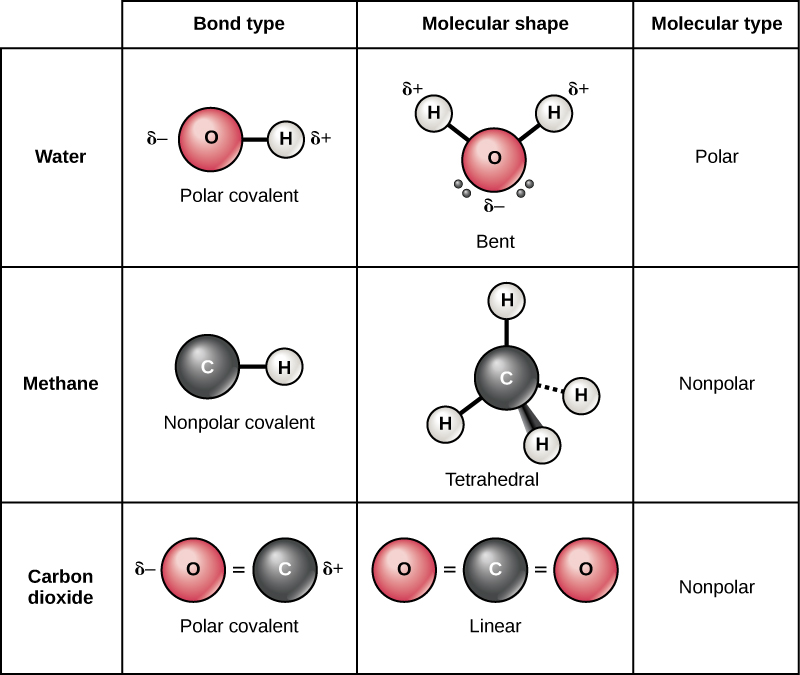
Hydrogen Bonds and Van Der Waals Interactions
Ionic and covalent bonds between elements require energy to break. Ionic bonds are not as strong as covalent, which determines their behavior in biological systems. Nonetheless, not all bonds are ionic or covalent bonds. Weaker bonds can also form between molecules. Ii weak bonds that occur frequently are hydrogen bonds and van der Waals interactions. Without these 2 types of bonds, life equally we know it would not exist. Hydrogen bonds provide many of the critical, life-sustaining properties of h2o and as well stabilize the structures of proteins and Deoxyribonucleic acid, the building block of cells.
When polar covalent bonds containing hydrogen form, the hydrogen in that bail has a slightly positive accuse because hydrogen'south electron is pulled more strongly toward the other chemical element and away from the hydrogen. Because the hydrogen is slightly positive, it will be attracted to neighboring negative charges. When this happens, a weak interaction occurs between the hydrogen's δ + from one molecule and another molecule's δ– charge on the more than electronegative atoms, usually oxygen or nitrogen, or inside the same molecule. Scientists phone call this interaction a hydrogen bond. This type of bond is mutual and occurs regularly betwixt water molecules. Individual hydrogen bonds are weak and easily broken; nonetheless, they occur in very big numbers in water and in organic polymers, creating a major force in combination. Hydrogen bonds are also responsible for zipping together the Dna double helix.
Like hydrogen bonds, van der Waals interactions are weak attractions or interactions between molecules. Van der Waals attractions can occur between any two or more molecules and are dependent on slight fluctuations of the electron densities, which are not always symmetrical effectually an atom. For these attractions to happen, the molecules need to be very close to one another. These bonds—along with ionic, covalent, and hydrogen bonds—contribute to the proteins' three-dimensional structure in our cells that is necessary for their proper function.
Career Connectedness
Pharmaceutical Chemist
Pharmaceutical chemists are responsible for developing new drugs and trying to determine the mode of action of both old and new drugs. They are involved in every footstep of the drug development process. We can find drugs in the natural environment or nosotros can synthesize them in the laboratory. In many cases, chemists chemically alter potential drugs from nature chemically in the laboratory to brand them safer and more effective, and sometimes constructed versions of drugs substitute for the version nosotros find in nature.
After a drug's initial discovery or synthesis, the chemist then develops the drug, mayhap chemically altering it, testing it to see if it is toxic, so designing methods for efficient big-scale production. Then, the procedure of blessing the drug for human use begins. In the The states, the Food and Drug Administration (FDA) handles drug approval. This involves a series of large-scale experiments using human subjects to ensure the drug is not harmful and finer treats the condition for which it is intended. This process often takes several years and requires the participation of physicians and scientists, in addition to chemists, to complete testing and gain approval.
An example of a drug that was originally discovered in a living organism is Paclitaxel (Taxol), an anti-cancer drug used to care for breast cancer. This drug was discovered in the bark of the pacific yew tree. Another example is aspirin, originally isolated from willow tree bark. Finding drugs often ways testing hundreds of samples of plants, fungi, and other forms of life to see if they contain any biologically agile compounds. Sometimes, traditional medicine can give mod medicine clues as to where to find an active compound. For example, mankind has used willow bark to make medicine for thousands of years, dating back to ancient Egypt. Yet, it was not until the belatedly 1800s that scientists and pharmaceutical companies purified and marketed the aspirin molecule, acetylsalicylic acrid, for human apply.
Occasionally, drugs developed for one use take unforeseen effects that let usage in other, unrelated means. For example, scientists originally developed the drug minoxidil (Rogaine) to care for loftier blood pressure. When tested on humans, researchers noticed that individuals taking the drug would grow new hair. Somewhen the pharmaceutical visitor marketed the drug to men and women with baldness to restore lost hair.
A pharmaceutical pharmacist's career may involve detective work, experimentation, and drug evolution, all with the goal of making man beings healthier.
Section Summary
Thing is anything that occupies space and has mass. Information technology is comprised of elements. All of the 98 elements that occur naturally have unique qualities that allow them to combine in diverse ways to create molecules, which in turn combine to class cells, tissues, organ systems, and organisms. Atoms, which consist of protons, neutrons, and electrons, are the smallest units of an element that retain all of the properties of that element. Electrons tin can transfer, share, or cause charge disparities between atoms to create bonds, including ionic, covalent, and hydrogen bonds, as well every bit van der Waals interactions.
Visual Connection Questions
(Figure) How many neutrons do carbon-12 and carbon-13 take, respectively?
(Figure) Carbon-12 has six neutrons. Carbon-13 has seven neutrons.
(Figure) An cantlet may give, take, or share electrons with another cantlet to achieve a full valence shell, the most stable electron configuration. Looking at this figure, how many electrons do elements in group ane need to lose in guild to achieve a stable electron configuration? How many electrons practise elements in groups 14 and 17 need to proceeds to accomplish a stable configuration?
(Figure) Elements in group one need to lose i electron to achieve a stable electron configuration. Elements in groups 14 and 17 demand to gain four and one electrons, respectively, to achieve a stable configuration.
Review Questions
If xenon has an diminutive number of 54 and a mass number of 108, how many neutrons does information technology have?
- 54
- 27
- 100
- 108
A
Atoms that vary in the number of neutrons constitute in their nuclei are called ________.
- ions
- neutrons
- neutral atoms
- isotopes
D
Potassium has an atomic number of 19. What is its electron configuration?
- shells 1 and 2 are total, and shell 3 has nine electrons
- shells 1, 2 and 3 are full and vanquish 4 has three electrons
- shells 1, 2 and 3 are total and shell 4 has one electron
- shells 1, 2 and iii are full and no other electrons are present
C
Which blazon of bond represents a weak chemic bond?
- hydrogen bond
- atomic bond
- covalent bond
- nonpolar covalent bond
A
Critical Thinking Questions
What makes ionic bonds dissimilar from covalent bonds?
Ionic bonds are created between ions. The electrons are non shared between the atoms, but rather are associated more with one ion than the other. Ionic bonds are potent bonds, simply are weaker than covalent bonds, meaning it takes less energy to pause an ionic bond compared with a covalent one.
Why are hydrogen bonds and van der Waals interactions necessary for cells?
Hydrogen bonds and van der Waals interactions form weak associations betwixt dissimilar molecules or within different regions of the same molecule. They provide the structure and shape necessary for proteins and Dna inside cells so that they function properly.
Glossary
- anion
- negative ion that is formed by an atom gaining 1 or more electrons
- cantlet
- the smallest unit of matter that retains all of the chemical properties of an element
- diminutive mass
- calculated hateful of the mass number for an element'southward isotopes
- diminutive number
- full number of protons in an atom
- counterbalanced chemic equation
- statement of a chemic reaction with the number of each type of atom equalized for both the products and reactants
- cation
- positive ion that is formed by an cantlet losing one or more electrons
- chemical bond
- interaction between two or more of the aforementioned or different atoms that results in forming molecules
- chemical reaction
- process leading to rearranging atoms in molecules
- chemical reactivity
- the ability to combine and to chemically bond with each other
- compound
- substance composed of molecules consisting of atoms of at least two different elements
- covalent bond
- blazon of strong bond formed between two atoms of the same or unlike elements; forms when electrons are shared between atoms
- electrolyte
- ion necessary for nerve impulse conduction, muscle contractions, and h2o residual
- electron
- negatively charged subatomic particle that resides outside of the nucleus in the electron orbital; lacks functional mass and has a negative accuse of –one unit of measurement
- electron configuration
- organisation of electrons in an atom'southward electron shell (for example, 1s22stwo2p6)
- electron orbital
- how electrons are spatially distributed surrounding the nucleus; the expanse where we are almost likely to find an electron
- electron transfer
- movement of electrons from one element to another; important in creating ionic bonds
- electronegativity
- ability of some elements to attract electrons (often of hydrogen atoms), acquiring partial negative charges in molecules and creating partial positive charges on the hydrogen atoms
- chemical element
- one of 118 unique substances that cannot interruption down into smaller substances; each element has unique properties and a specified number of protons
- equilibrium
- steady state of relative reactant and product concentration in reversible chemical reactions in a closed system
- hydrogen bail
- weak bail between slightly positively charged hydrogen atoms and slightly negatively charged atoms in other molecules
- inert gas
- (also, element of group 0) element with filled outer electron vanquish that is unreactive with other atoms
- ion
- cantlet or chemical grouping that does not contain equal numbers of protons and electrons
- ionic bond
- chemical bail that forms between ions with opposite charges (cations and anions)
- irreversible chemical reaction
- chemic reaction where reactants proceed unidirectionally to form products
- isotope
- ane or more forms of an element that have different numbers of neutrons
- law of mass activeness
- chemical law stating that the rate of a reaction is proportional to the concentration of the reacting substances
- mass number
- total number of protons and neutrons in an cantlet
- matter
- anything that has mass and occupies space
- molecule
- two or more than atoms chemically bonded together
- neutron
- uncharged particle that resides in an cantlet'southward nucleus; has a mass of one amu
- noble gas
- come across inert gas
- nonpolar covalent bond
- type of covalent bond that forms between atoms when electrons are shared equally between them
- nucleus
- cadre of an atom; contains protons and neutrons
- octet rule
- dominion that atoms are well-nigh stable when they concur eight electrons in their outermost shells
- orbital
- region surrounding the nucleus; contains electrons
- periodic table
- organizational chart of elements indicating each element's diminutive number and diminutive mass; provides key information about the elements' backdrop
- polar covalent bond
- type of covalent bond that forms as a result of unequal electron sharing, resulting in creating slightly positive and negative charged molecule regions
- production
- molecule that is result of chemical reaction
- proton
- positively charged particle that resides in the cantlet'south nucleus; has a mass of one amu and a accuse of +1
- radioisotope
- isotope that emits radiation comprised of subatomic particles to grade more than stable elements
- reactant
- molecule that takes part in a chemical reaction
- reversible chemical reaction
- chemical reaction that functions bidirectionally, where products may turn into reactants if their concentration is great enough
- valence beat out
- outermost shell of an atom
- van der Waals interaction
- very weak interaction between molecules due to temporary charges alluring atoms that are very close together
mckinneytagning1948.blogspot.com
Source: https://opentextbc.ca/biology2eopenstax/chapter/atoms-isotopes-ions-and-molecules-the-building-blocks/
0 Response to "Worksheet Review of Atoms Molecules Ions and Isotopes"
Post a Comment